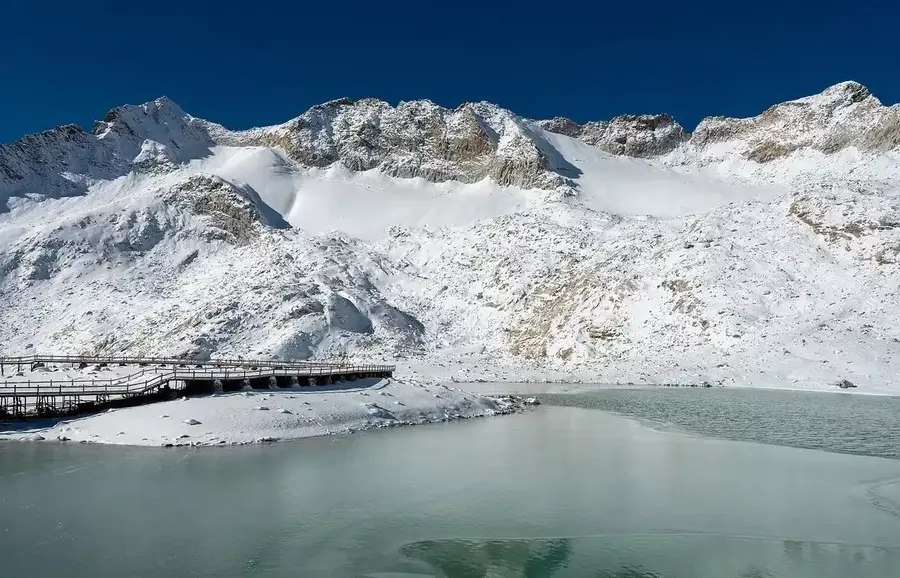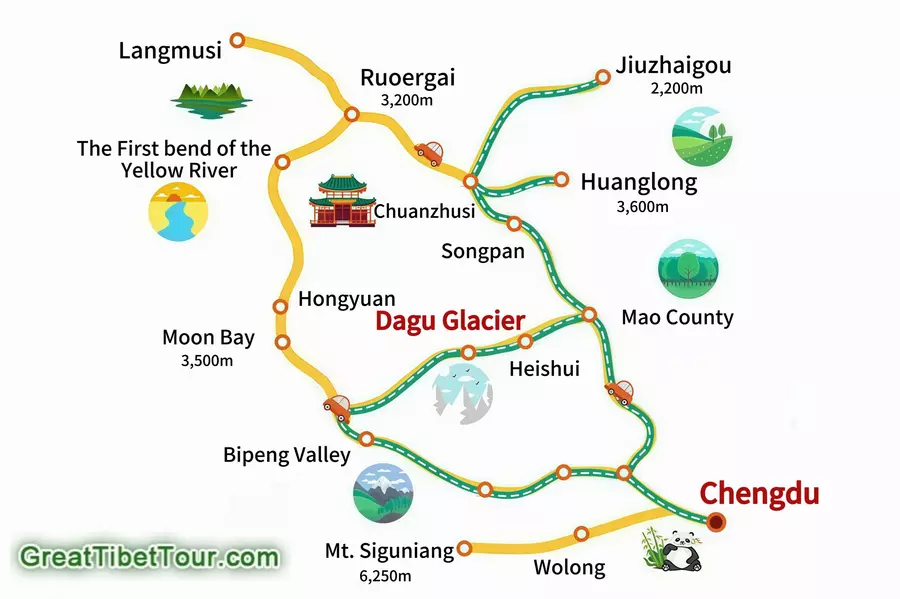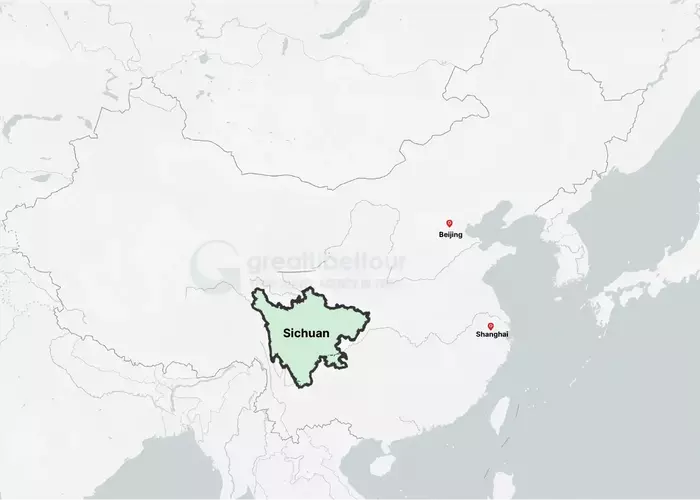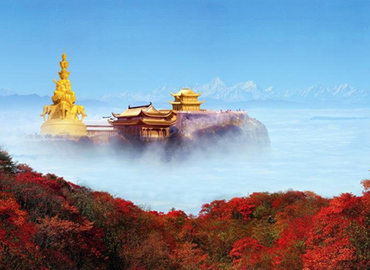Dagu Glacier
- Emily
- Última actualización : 22/11/2025
Hidden deep in the mountains of western Sichuan, Dagu Glacier National Park is a breathtaking natural wonder—soaring snow peaks, shimmering ice lakes, and a landscape that feels both peaceful and majestic. Located in Heishui County of Aba Tibetan and Qiang Autonomous Prefecture, Dagu Glacier is home to one of the world’s lowest-altitude, largest, youngest, and most accessible glaciers, remarkably close to major cities.
Its highest peak rises above 5,000 meters, with snow blanketing the glacier year-round. The surrounding valleys shift dramatically with the seasons: fiery forests in autumn, and a pure, white world in winter. For travelers, it’s a rare chance to explore untouched nature. Whether you come to chase fall colors, immerse yourself in winter snowcapes, or sit quietly in the mountaintop café to savor the solitude and grandeur, Dagu Glacier offers every visitor an unforgettable journey across the Tibetan Plateau. It is not just a travel destination — it is a voyage into the very heart of nature.

Travel Guide
- Chinese Name: 达古冰川
- English Name: Dagu Glacier National Park
- Ticket Prices: Entrance: 120 RMB/person; Cable Car: 180 RMB/person; Sightseeing Bus: 70 RMB/person
- Opening Hours: May 1st–December 15th: 08:00–17:30; December 16th–April 30th: 08:30–17:30
- Location: Heishui County, Aba Tibetan and Qiang Autonomous Prefecture, Sichuan Province
- Distance from Chengdu: Approximately 260–300 km, about 5–6 hours by car
- Elevation: 3,800–5,100 meters
Geography & Formation
Dagu Glacier was formed during the Quaternary Period (over 2 million years ago), and is considered a geologically young glacier. Its unusually low altitude (with the glacier tongue starting at around 3,000 meters)allows visitors to experience the awe-inspiring scenery of a high mountain glacier without extreme conditions.
The park covers an area of approximately 210 square kilometers, with over 200 glacial lakes scattered between its valleys and ridges. Three main glaciers—Glacier No. 1, Glacier No. 2, and Glacier No. 3—stretch across the mountains like frozen rivers, their silver-blue ice shimmering under the sunlight. Among them, Glacier No. 1 is the most famous, and visitors can easily reach it by taking the high-altitude cable car.
Best Time to Visit
Dagu Glacier has own unique charm in every season, with each offering distinctive natural scenery and activities. The best season for sightseeing is autumn, while winter is ideal for adventure. You can choose the best time to visit based on your interests.
Spring (April–June):
As the snow begins to melt, wildflowers blanket the valleys and meadows. Forests turn lush green, and rushing streams feed the glacier lakes with crystal-clear water. It’s an ideal season for photography and easy hikes.
Summer (July–September):
Daytime temperatures hover around 15°C, with fresh air and ample oxygen. Visitors can enjoy views of grazing yaks and vibrant alpine landscapes. Occasional showers enhance the colors of the mountains, but roads in the area may be slippery, so caution is advised.
Autumn (October–November):
Autumn is the most spectacular season. The valleys turn red, orange, and gold, creating a dramatic contrast with the white glacier. The annual “Glacier Colorful Forest Festival” showcases both the region’s natural beauty and the rich Tibetan–Qiang culture—perfect for photography lovers.
Winter (December–March):
Winter is a serene world of snow and ice, making it the ideal time for glacier trekking, light ice climbing, and enjoying the snowy plateau scenery. The crisp air and high visibility allow for breathtaking views of the continuous snow-capped mountains and striking blue ice.
Note: July and August are the rainy season. Mountain roads may be slippery, so extra caution is recommended.

Highlights & Experiences
Blue Ice & Glacier Views
Dagu Glacier is renowned for its stunning blue-ice scenery. The blue ice hidden within the glacier and its crevasses glitters under the sunlight like natural gemstones. At an altitude of 4,860 meters, standing before this luminous ice feels like touching the very heart of the glacier. It is an unmissable sight for both photographers and adventure lovers.
Cable Car Experience
Take the world’s highest cable car, rising from about 3,000 meters to 4,860 meters in just 15 minutes. Along the way, the scenery shifts from dense forests to alpine meadows and finally to a snow-covered glacier world. From the upper station’s viewing platform, you can overlook rolling snow-capped peaks, shimmering ice lakes, and winding streams—an impressive blend of high-altitude grandeur and quiet serenity.
The Summit Café
At the top of the glacier sits “the loneliest café in the world,” surrounded by silent mountains and endless ice. Sipping a cup of hot coffee or tea here, listening to the wind against the mountains, becomes a profound and unforgettable experience.
Boardwalk Trails
Inside the park, well-kept boardwalks meander through forests, meadows, streams, and glacier wetlands. The air is fresh and pristine. Along the way, you may spot wildflowers, moss-covered rocks, and occasionally Tibetan macaques or other wildlife—inviting visitors to experience the richness and diversity of high-altitude ecosystems up close.
Glacier Lakes
More than 200 glacier lakes are scattered throughout Dagu Glacier, with Dagu Lake being the most famous; the other lakes include Zena Lake, Golden Monkey Lake, etc. Its turquoise water mirrors the surrounding glaciers and forests. The easy walking paths around the lake make it a perfect spot for photography, relaxation, and soaking in the beauty of nature.

Suggested Itinerary
If you're looking for a short yet scenic journey through Western Sichuan, this route connects some of the region's most stunning landscapes in a natural progression. From Chengdu, you rise into Huanglong's crystal-blue terraces, continue into the dreamlike valleys of Jiuzhaigou, and conclude on the high-altitude snowfields of Dagu Glacier—where the views stretch across a sea of clouds. If you prefer a more relaxed pace, you can also extend the trip to four days.
Day 1: Chengdu → Huanglong Scenic Area → Jiuzhaigou (overnight)
Day 2: Jiuzhaigou full-day tour → Mao County (overnight)
Day 3: Dagu Glacier cable car and sightseeing → Return to Chengdu
Extended Options:
I - 5 Day trip: Chengdu – Jiuzhaigou – Ruo’ergai Grassland – Hongyuan – Wolong Panda Base – Chengdu
II. - 3 Day trip: Chengdu – Mao County – Dagu Glacier – Gurgou Hot Springs (Li County) – Bipeng Valley – Chengdu
The route can also be extended to Bipeng Valley or Mount Siguniang, creating a longer Western Sichuan highland circuit. Contact us for a customized plan.

How to Get to Dagu Glacier
Dagu Glacier is accessible only by road. You can directly go to Chengdu’s Chadianzi Bus Station to take long-distance buses that run to Heishui County (approximately 6–7 hours). During peak tourist season, such as the autumn, you are advised to book Chengdu–Heishui bus tickets through Etrip China in advance. Upon your arrival in Heishui County, you can take local taxis or minibuses to reach the park in 30 minutes.
For a more relaxed and comfortable journey, we recommend a private guide and car service. Your trip can start directly from your hotel in Chengdu, with flexible routing to the scenic areas for a fantastic highland experience.
Travel Tips
- High-Altitude Precautions: The cable car reaches nearly 4,900 meters, and some visitors may experience mild shortness of breath. Please avoid strenuous activities such as running or jumping.
- Warm Clothing: Temperatures can vary by over 20°C between day and night. Bring layers, gloves, and a hat.
- Sun Protection: Strong UV rays at high altitude make sunscreen, sunglasses, and lip balm essential.
- Accommodation: Lodging in Heishui and near the park is clean and comfortable, though simple—offering a chance to experience Tibetan and Qiang culture.
- Connectivity & Cash: Some areas have weak signals. Carry some cash as backup.
- Battery Care: Cold drains batteries quickly; bring a power bank.
- Drones: Allowed in the park, but be cautious of high-altitude winds.
- Respect Local Customs: Always ask before visiting villages or temples. Walk clockwise around stupas and other religious sites.
Culture & Ecology
The area around Dagu Glacier is rich in cultural heritage, with nearby villages preserving traditional Tibetan and Qiang architecture, prayer flags, and ancient customs. Visitors can taste butter tea and experience authentic highland life.
The park emphasizes ecological conservation and promotes sustainable tourism, preserving its pristine environment and the vitality of its wildlife. With quiet observation, you may encounter Tibetan macaques, blue sheep, yaks, and rare bird species, experiencing the true charm of the natural ecosystem.
Conclusions
Dagu Glacier National Park offers a rare chance to experience high-altitude landscapes in a peaceful and accessible way. From glacier views and blue-ice formations to quiet lakes, forests, and cultural encounters, the park allows travelers to appreciate the richness of western Sichuan's natural world at their own pace. It is a place where every season reveals a different side of the plateau, making each visit meaningful in its own way.
Respuesta por correo dentro de 0.5 a 24 horas.







